Ryota Tanaka
VIFSS: View-Invariant and Figure Skating-Specific Pose Representation Learning for Temporal Action Segmentation
Aug 14, 2025Abstract:Understanding human actions from videos plays a critical role across various domains, including sports analytics. In figure skating, accurately recognizing the type and timing of jumps a skater performs is essential for objective performance evaluation. However, this task typically requires expert-level knowledge due to the fine-grained and complex nature of jump procedures. While recent approaches have attempted to automate this task using Temporal Action Segmentation (TAS), there are two major limitations to TAS for figure skating: the annotated data is insufficient, and existing methods do not account for the inherent three-dimensional aspects and procedural structure of jump actions. In this work, we propose a new TAS framework for figure skating jumps that explicitly incorporates both the three-dimensional nature and the semantic procedure of jump movements. First, we propose a novel View-Invariant, Figure Skating-Specific pose representation learning approach (VIFSS) that combines contrastive learning as pre-training and action classification as fine-tuning. For view-invariant contrastive pre-training, we construct FS-Jump3D, the first publicly available 3D pose dataset specialized for figure skating jumps. Second, we introduce a fine-grained annotation scheme that marks the ``entry (preparation)'' and ``landing'' phases, enabling TAS models to learn the procedural structure of jumps. Extensive experiments demonstrate the effectiveness of our framework. Our method achieves over 92% F1@50 on element-level TAS, which requires recognizing both jump types and rotation levels. Furthermore, we show that view-invariant contrastive pre-training is particularly effective when fine-tuning data is limited, highlighting the practicality of our approach in real-world scenarios.
KASportsFormer: Kinematic Anatomy Enhanced Transformer for 3D Human Pose Estimation on Short Sports Scene Video
Jul 28, 2025Abstract:Recent transformer based approaches have demonstrated impressive performance in solving real-world 3D human pose estimation problems. Albeit these approaches achieve fruitful results on benchmark datasets, they tend to fall short of sports scenarios where human movements are more complicated than daily life actions, as being hindered by motion blur, occlusions, and domain shifts. Moreover, due to the fact that critical motions in a sports game often finish in moments of time (e.g., shooting), the ability to focus on momentary actions is becoming a crucial factor in sports analysis, where current methods appear to struggle with instantaneous scenarios. To overcome these limitations, we introduce KASportsFormer, a novel transformer based 3D pose estimation framework for sports that incorporates a kinematic anatomy-informed feature representation and integration module. In which the inherent kinematic motion information is extracted with the Bone Extractor (BoneExt) and Limb Fuser (LimbFus) modules and encoded in a multimodal manner. This improved the capability of comprehending sports poses in short videos. We evaluate our method through two representative sports scene datasets: SportsPose and WorldPose. Experimental results show that our proposed method achieves state-of-the-art results with MPJPE errors of 58.0mm and 34.3mm, respectively. Our code and models are available at: https://github.com/jw0r1n/KASportsFormer
VDocRAG: Retrieval-Augmented Generation over Visually-Rich Documents
Apr 14, 2025Abstract:We aim to develop a retrieval-augmented generation (RAG) framework that answers questions over a corpus of visually-rich documents presented in mixed modalities (e.g., charts, tables) and diverse formats (e.g., PDF, PPTX). In this paper, we introduce a new RAG framework, VDocRAG, which can directly understand varied documents and modalities in a unified image format to prevent missing information that occurs by parsing documents to obtain text. To improve the performance, we propose novel self-supervised pre-training tasks that adapt large vision-language models for retrieval by compressing visual information into dense token representations while aligning them with textual content in documents. Furthermore, we introduce OpenDocVQA, the first unified collection of open-domain document visual question answering datasets, encompassing diverse document types and formats. OpenDocVQA provides a comprehensive resource for training and evaluating retrieval and question answering models on visually-rich documents in an open-domain setting. Experiments show that VDocRAG substantially outperforms conventional text-based RAG and has strong generalization capability, highlighting the potential of an effective RAG paradigm for real-world documents.
AthletePose3D: A Benchmark Dataset for 3D Human Pose Estimation and Kinematic Validation in Athletic Movements
Mar 11, 2025Abstract:Human pose estimation is a critical task in computer vision and sports biomechanics, with applications spanning sports science, rehabilitation, and biomechanical research. While significant progress has been made in monocular 3D pose estimation, current datasets often fail to capture the complex, high-acceleration movements typical of competitive sports. In this work, we introduce AthletePose3D, a novel dataset designed to address this gap. AthletePose3D includes 12 types of sports motions across various disciplines, with approximately 1.3 million frames and 165 thousand individual postures, specifically capturing high-speed, high-acceleration athletic movements. We evaluate state-of-the-art (SOTA) monocular 2D and 3D pose estimation models on the dataset, revealing that models trained on conventional datasets perform poorly on athletic motions. However, fine-tuning these models on AthletePose3D notably reduces the SOTA model mean per joint position error (MPJPE) from 214mm to 65mm-a reduction of over 69%. We also validate the kinematic accuracy of monocular pose estimations through waveform analysis, highlighting strong correlations in joint angle estimations but limitations in velocity estimation. Our work provides a comprehensive evaluation of monocular pose estimation models in the context of sports, contributing valuable insights for advancing monocular pose estimation techniques in high-performance sports environments. The dataset, code, and model checkpoints are available at: https://github.com/calvinyeungck/AthletePose3D
3D Pose-Based Temporal Action Segmentation for Figure Skating: A Fine-Grained and Jump Procedure-Aware Annotation Approach
Aug 29, 2024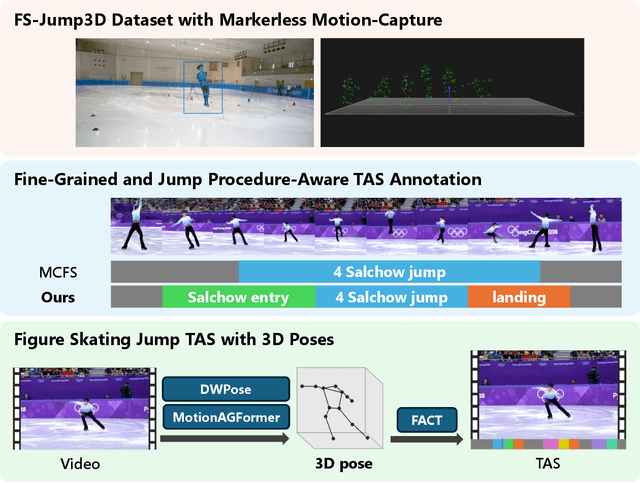

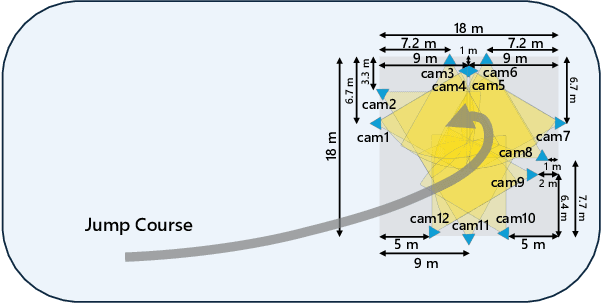

Abstract:Understanding human actions from videos is essential in many domains, including sports. In figure skating, technical judgments are performed by watching skaters' 3D movements, and its part of the judging procedure can be regarded as a Temporal Action Segmentation (TAS) task. TAS tasks in figure skating that automatically assign temporal semantics to video are actively researched. However, there is a lack of datasets and effective methods for TAS tasks requiring 3D pose data. In this study, we first created the FS-Jump3D dataset of complex and dynamic figure skating jumps using optical markerless motion capture. We also propose a new fine-grained figure skating jump TAS dataset annotation method with which TAS models can learn jump procedures. In the experimental results, we validated the usefulness of 3D pose features as input and the fine-grained dataset for the TAS model in figure skating. FS-Jump3D Dataset is available at https://github.com/ryota-skating/FS-Jump3D.
Empirical Analysis of Large Vision-Language Models against Goal Hijacking via Visual Prompt Injection
Aug 07, 2024Abstract:We explore visual prompt injection (VPI) that maliciously exploits the ability of large vision-language models (LVLMs) to follow instructions drawn onto the input image. We propose a new VPI method, "goal hijacking via visual prompt injection" (GHVPI), that swaps the execution task of LVLMs from an original task to an alternative task designated by an attacker. The quantitative analysis indicates that GPT-4V is vulnerable to the GHVPI and demonstrates a notable attack success rate of 15.8%, which is an unignorable security risk. Our analysis also shows that successful GHVPI requires high character recognition capability and instruction-following ability in LVLMs.
InstructDoc: A Dataset for Zero-Shot Generalization of Visual Document Understanding with Instructions
Jan 24, 2024Abstract:We study the problem of completing various visual document understanding (VDU) tasks, e.g., question answering and information extraction, on real-world documents through human-written instructions. To this end, we propose InstructDoc, the first large-scale collection of 30 publicly available VDU datasets, each with diverse instructions in a unified format, which covers a wide range of 12 tasks and includes open document types/formats. Furthermore, to enhance the generalization performance on VDU tasks, we design a new instruction-based document reading and understanding model, InstructDr, that connects document images, image encoders, and large language models (LLMs) through a trainable bridging module. Experiments demonstrate that InstructDr can effectively adapt to new VDU datasets, tasks, and domains via given instructions and outperforms existing multimodal LLMs and ChatGPT without specific training.
SlideVQA: A Dataset for Document Visual Question Answering on Multiple Images
Jan 12, 2023Abstract:Visual question answering on document images that contain textual, visual, and layout information, called document VQA, has received much attention recently. Although many datasets have been proposed for developing document VQA systems, most of the existing datasets focus on understanding the content relationships within a single image and not across multiple images. In this study, we propose a new multi-image document VQA dataset, SlideVQA, containing 2.6k+ slide decks composed of 52k+ slide images and 14.5k questions about a slide deck. SlideVQA requires complex reasoning, including single-hop, multi-hop, and numerical reasoning, and also provides annotated arithmetic expressions of numerical answers for enhancing the ability of numerical reasoning. Moreover, we developed a new end-to-end document VQA model that treats evidence selection and question answering in a unified sequence-to-sequence format. Experiments on SlideVQA show that our model outperformed existing state-of-the-art QA models, but that it still has a large gap behind human performance. We believe that our dataset will facilitate research on document VQA.
VisualMRC: Machine Reading Comprehension on Document Images
Jan 27, 2021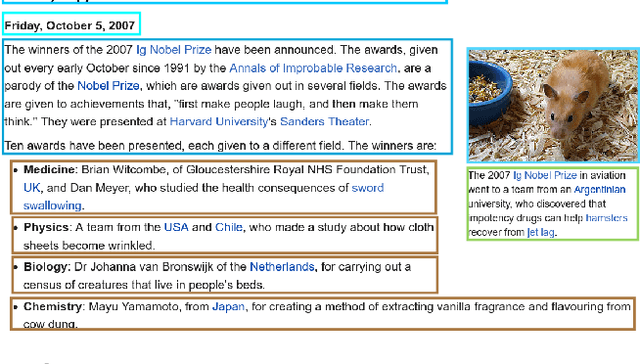
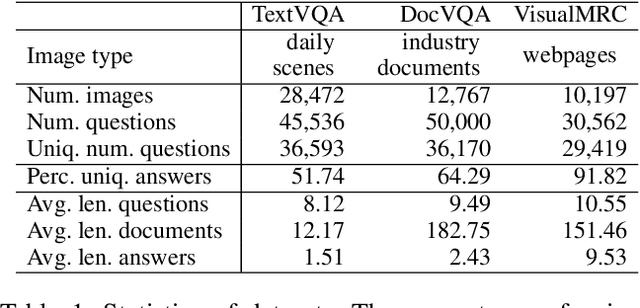
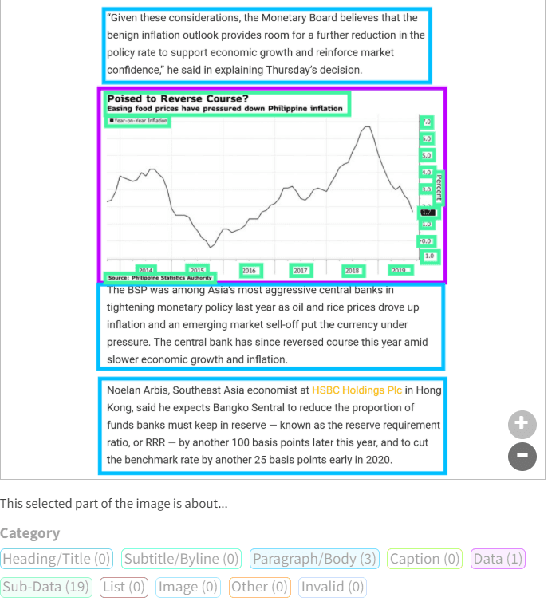
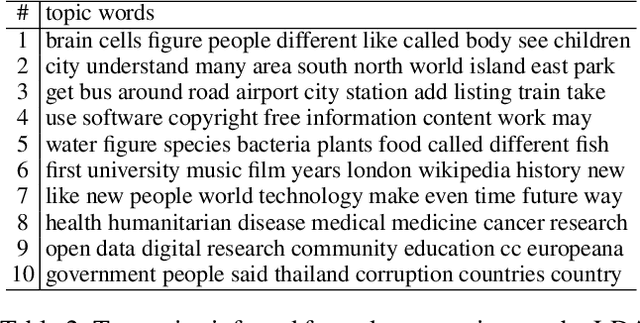
Abstract:Recent studies on machine reading comprehension have focused on text-level understanding but have not yet reached the level of human understanding of the visual layout and content of real-world documents. In this study, we introduce a new visual machine reading comprehension dataset, named VisualMRC, wherein given a question and a document image, a machine reads and comprehends texts in the image to answer the question in natural language. Compared with existing visual question answering (VQA) datasets that contain texts in images, VisualMRC focuses more on developing natural language understanding and generation abilities. It contains 30,000+ pairs of a question and an abstractive answer for 10,000+ document images sourced from multiple domains of webpages. We also introduce a new model that extends existing sequence-to-sequence models, pre-trained with large-scale text corpora, to take into account the visual layout and content of documents. Experiments with VisualMRC show that this model outperformed the base sequence-to-sequence models and a state-of-the-art VQA model. However, its performance is still below that of humans on most automatic evaluation metrics. The dataset will facilitate research aimed at connecting vision and language understanding.
Fact-based Dialogue Generation with Convergent and Divergent Decoding
May 08, 2020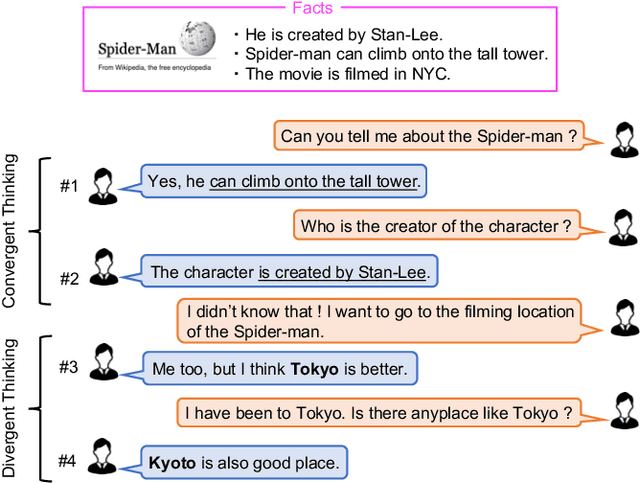

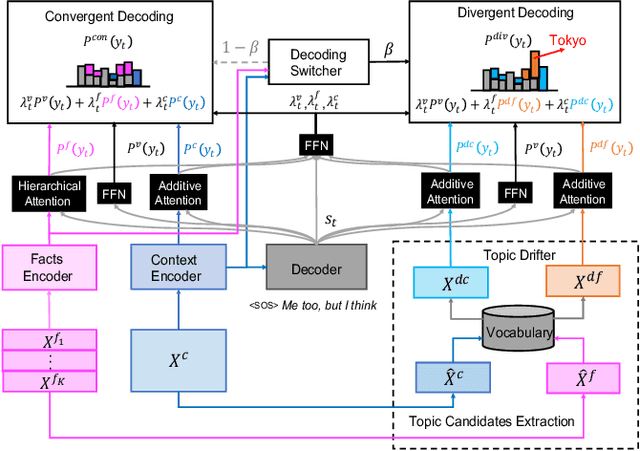
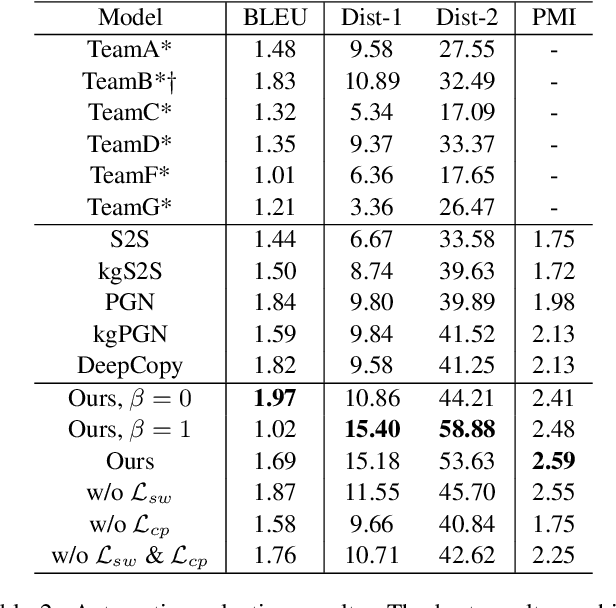
Abstract:Fact-based dialogue generation is a task of generating a human-like response based on both dialogue context and factual texts. Various methods were proposed to focus on generating informative words that contain facts effectively. However, previous works implicitly assume a topic to be kept on a dialogue and usually converse passively, therefore the systems have a difficulty to generate diverse responses that provide meaningful information proactively. This paper proposes an end-to-end fact-based dialogue system augmented with the ability of convergent and divergent thinking over both context and facts, which can converse about the current topic or introduce a new topic. Specifically, our model incorporates a novel convergent and divergent decoding that can generate informative and diverse responses considering not only given inputs (context and facts) but also inputs-related topics. Both automatic and human evaluation results on DSTC7 dataset show that our model significantly outperforms state-of-the-art baselines, indicating that our model can generate more appropriate, informative, and diverse responses.
 Add to Chrome
Add to Chrome Add to Firefox
Add to Firefox Add to Edge
Add to Edge